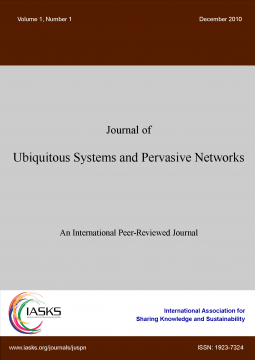volume-09-Issue 2 (2017)
Latest Articles
Content-aware and QoE Optimization of Video Stream Scheduling over LTE Networks using Genetic Algorithm and Random Neural Networks
JUSPN, volume-09, Issue 2 (2017) , PP 21 - 33
Published: 09 May 2017
DOI: 10.5383/JUSPN.09.02.003
by Tarik Ghaluta, Hadi Larijani from Glasgow Caledonian University, Cowcaddens Rd, Glasgow G4 0BA, UK
Abstract: Long Term Evolution (LTE) networks support Quality of Service (QoS) of multimedia services with fast communication connectivity, high data transfer speed and high level of security. Video streaming over LTE networks is one of the highest proportions of global mobile data traffic and is growing; this has led to the development of several scheduling algorithms aimed at improving the performance of these networks. The performance analysis and evaluation of existing scheduling algorithms are generally limited to QoS parameters. It is not clear how these scheduling algorithms perform in terms of Quality of Experience (QoE) which is the overall acceptability of a service or application, as perceived subjectively by end users. Video content has a major impact on QoE; thus its analysis in scheduling algorithms performance is critical. The aim of this study is to classify video content based on the impact of video content on quality over LTE networks. This classification is then used to develop novel QoE-aware optimization scheduling of video traffic in order to achieve maximum QoE. Our approach focuses on the development of optimization downlink scheduling based on a novel integration between random neural networks (RNN) and genetic algorithms (GA) to learn complex non-linear mapping of QoE and to search for the optimal parameters, respectively. An open source simulation tool for LTE networks (LTE-Sim) has been used to collect unique RNN training database based on existing scheduling algorithms. A comparison between the proposed scheduler and state-of-the-art LTE downlink scheduling algorithms (FLS, EXP-rule, and LOG-rule) has been made under different network conditions. Simulation results showed an increase in performance of about 15% in terms of QoE and throughput while maintaining fairness. read more... read less...
Keywords: Content Classification, GA, RNN, QoE, Scheduling Algorithm
Evaluation of Privacy Preserving In-Network Aggregation for Different Routing Structures in WSNs
JUSPN, volume-09, Issue 2 (2017) , PP 15 - 19
Published: 09 May 2017
DOI: 10.5383/JUSPN.09.02.002
by Vishal Krishna Singh, Saurabh Verma, Manish Kumar from Indian Institute of Information Technology, Devghat, Jhalwa, Allahabad, 211012, Uttar Pradesh, India
Abstract: Designing secure aggregation protocols for efficient data collection is driven mainly by preserving the privacy and integrity of the network data. Targeting the false data injection attack in wireless sensor networks (WSNs), a secure innetwork aggregation scheme for preserving the privacy of the data, is proposed in this work. The proposed scheme is able to compute the SUM, MEAN and COUNT of the network data based on an encryption scheme which uses pallier cryptosystem. Extensive analysis with different routing structures (cluster, tree and chain) are used for validating the efficacy of the proposed scheme over existing approaches. read more... read less...
Keywords: In-network data aggregation, Network lifetime, Pallier cryptosystem, Privacy, Wireless sensor networks
Virtual Resources & Blockchain for Configuration Management in IoT
JUSPN, volume-09, Issue 2 (2017) , PP 01 - 13
Published: 09 May 2017
DOI: 10.5383/JUSPN.09.02.001
by Mayra Samaniego, Ralph Deters from University of Saskatchewan, Saskatoon, Canada, S7N 5C9
Abstract: Until now, most systems for Internet of Things (IoT) management, have been designed in a Cloud-centric manner, getting benefits from the unified platform that the Cloud offers. However, a Cloud-centric infrastructure mainly achieves static sensor and data streaming systems, which do not support the direct configuration management of IoT components. To address this issue, a virtualization of IoT components (Virtual Resources) is introduced at the edge of the IoT network. This research also introduces permission-based Blockchain protocols to handle the provisioning of Virtual Resources directly onto edge devices. The architecture presented by this research focuses on the use of Virtual Resources and Blockchain protocols as management tools to distribute configuration tasks towards the edge of the IoT network. Results from lab experiments demonstrate the successful deployment and communication performance (response time in milliseconds) of Virtual Resources on two edge platforms, Raspberry Pi and Edison board. This work also provides performance evaluations of two permission-based blockchain protocol approaches. The first blockchain approach is a Blockchain as a Service (BaaS) in the Cloud, Bluemix. The second blockchain approach is a private cluster hosted in a Fog network, Multichain. read more... read less...
Keywords: IoT, Configuration Management, Virtual Resource, Blockchain, Fog, REST

